Advertising
I’d Rather Be Writing (idratherbewriting.com) is one of the most popular sites where technical writers and engineers go to stay updated with the latest technical writing news, trends, and information in the industry, especially API documentation. I can help increase your product or service’s visibility more than any other technical writing site online.
During the calendar year of 2022, idratherbewriting.com had 1,535,622 page views, or about 4,207 page views a day. For details about site metrics, audience, and popular content, see Site analytics.
The following sections describe the advertising spaces and options.
Ad space options and costs
| Ad space | Cost |
|---|---|
| Inline ads | $1,200/year |
| Sidebar ads | $1,000/year |
| Getting started tutorials | $2,000/post |
| Product Q&A post | $750/post |
| Inline text snippets | $1,800/year |
| Newsletter summaries | $150/newsletter |
| Newsletter banners | $100/newsletter |
| Footer banners | $1,500/year |
Billing is done through Paypal; it can also be handled through wire transfer or even check. (Even if you use another payment method, I use PayPal to keep track of invoices.) Billing is done prior to any advertising efforts.
Inline ads
Inline ads include one 250px x 150px graphic and a link to an article. The inline ad appears directly inline in the post — sometimes a third of the way down, half way down, or at the bottom of the post (the position is somewhat random). Here’s an example:
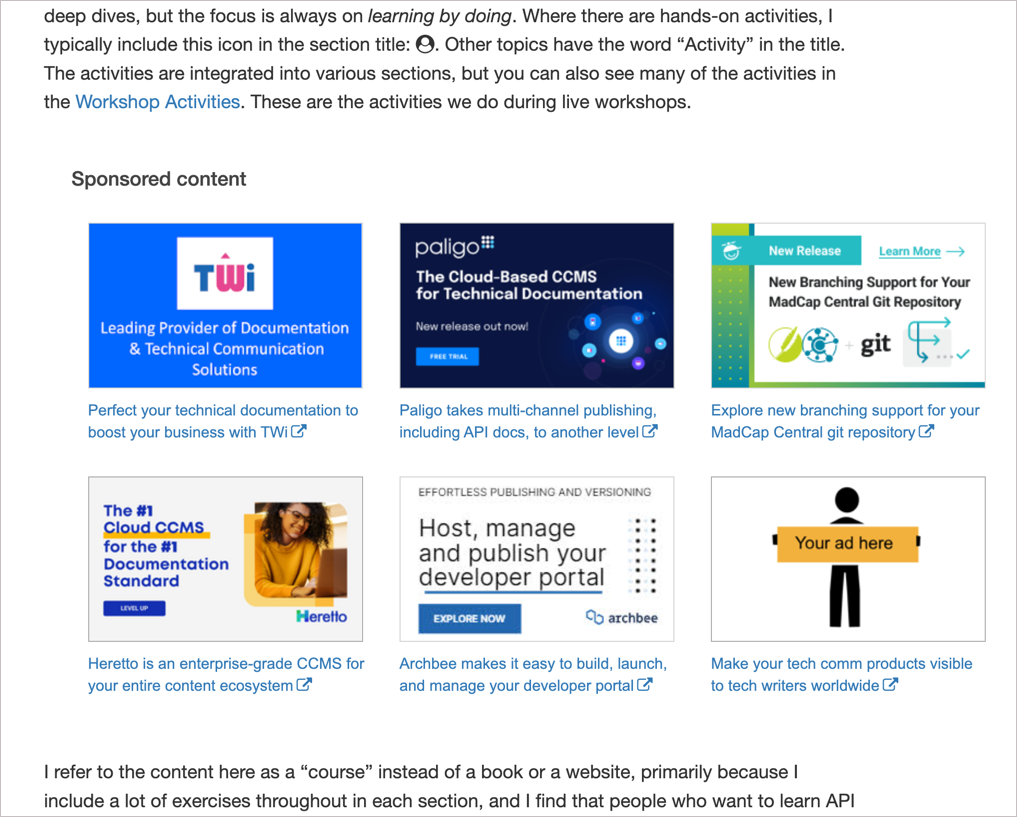
Here are more details about inline ads:
- Inline ads receive approximately 430 clicks per year.
- Each ad block can contain a maximum of six ads. Within the ad block, the ads randomly rotate positions each time the page refreshes. There is no specific hierarchy to ads in the inline ads.
- Your graphic format can be PNG, JPG, or SVG, but not an animated GIF.
- The graphic dimensions must be exactly 250 x 150px pixels in size. (As a tip, keep text readable at a glance, especially this size.)
- You can switch the ad at any time by sending me a new graphic.
- The ads are prefaced with a subheading that says “Sponsored ads” and the ad links have
ref="nofollow". The ads appear on every page of my site — both the blog and API course. - The graphics are accompanied by a post that invites users to click the link. The post title should be both relevant and enticing for a tech comm audience.
- To track links, I shorten any URLs you provide to me with Rebrandly. This allows me to track link clicks as well.
The cost for an inline ad is $1,200 per year.
Sidebar ads
Sidebar ads include a 250px x 150px graphic with an article link below the graphic. Sidebar ads appear in the left sidebar and randomly rotate positions each time the page refreshes — this helps refocus the reader’s attention on the ads. As with inline ads, there isn’t a specific hierarchy to ads in the sidebar.
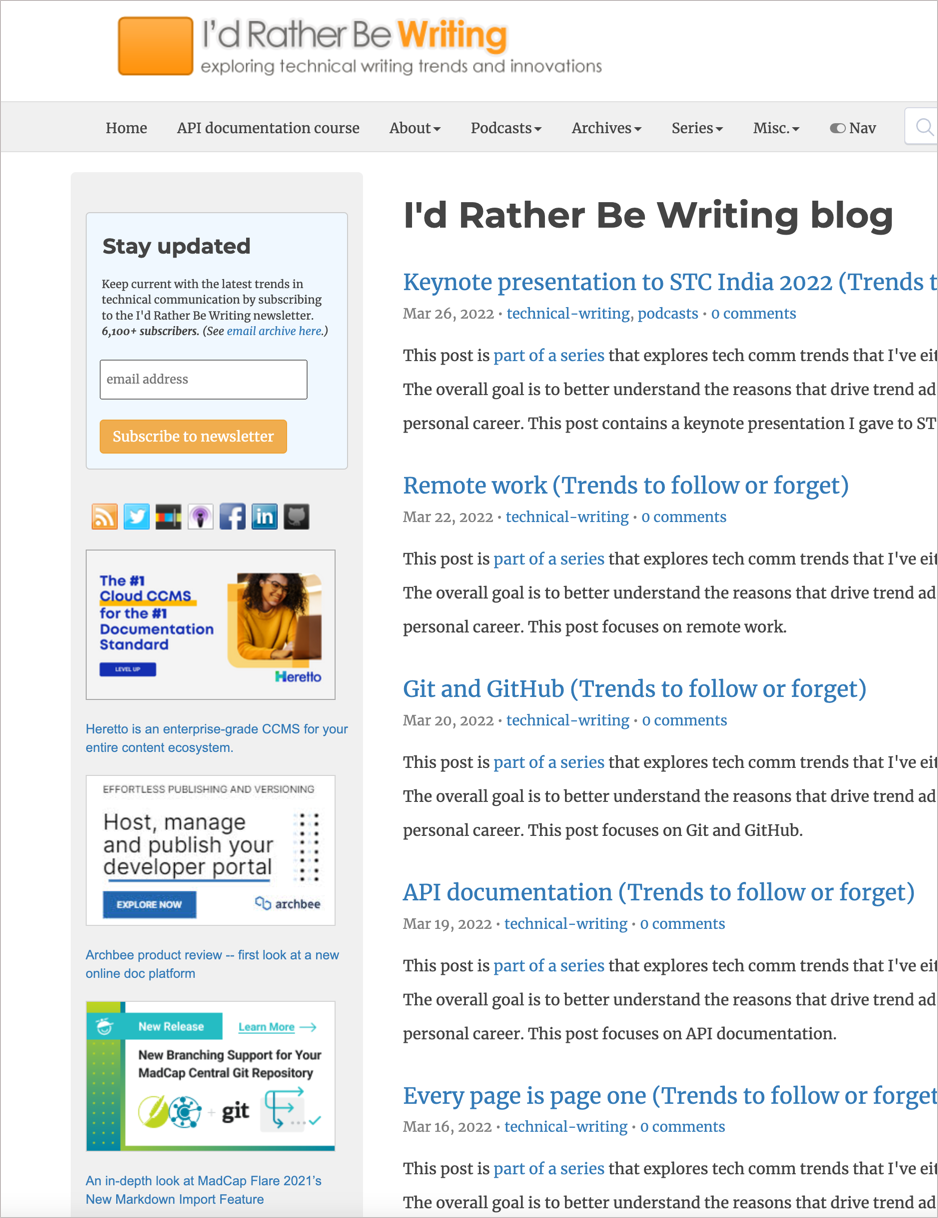
Sidebar ads have all of the same details as inline ads except they appear in the sidebar rather than inline in the post or page.
Sidebar ads receive approximately 400 clicks per year.
The sidebar ads appear after any sidebar navigation links. For example, for the API doc course, the sidebar ads appear after the page navigation in the left. On the blog, if there’s a series, such as this series on trends, the sidebar ads appear below the page navigation.
The cost for sidebar ads is $1,000 per year.
Getting started tutorials
Getting started tutorials are approximately 2,000 word posts that provide a brief overview of your product and then explain how to get started with it.
These posts can provide more visibility than other forms of advertising. A popular getting-started tutorial can receive much more visibility and have more impact than a banner ad.
Here are a few examples:
- Getting started tutorial: Using Stoplight Studio to create an OpenAPI specification document. This post received 14,800 page views in 2022.
- Redocly tutorial – authoring and publishing API docs with Redocly’s command-line tools. This post received 3,566 page views in 2022.
- Using Oxygen XML with docs-as-code workflows. This post received 9,326 page views in 2022.
The number of page views depends on the popularity of the product. On the low end, you can expect about 1,500 page views. On the high-end, you can expand around 10,000 page views.
To write this getting started tutorial, I’ll need to learn a bit about your product and play around with it. You will also need to provide a one-hour demo showing how to get started with your product.
The cost for a getting started tutorial is $2,000. If the material is appropriate to be placed in my API doc course, I may choose to add it there.
Product Q&A posts
Product Q&A posts are posts where I ask you about 10 questions or so and you answer them. These Q&A posts are an easy way for you to tell your story, without requiring you to structure and organize content into a coherent article. Here are two examples of Q&A posts:
- Technical writing course Q&A – ‘Become a Technical Writer’, with Bobby Kennedy. This post received 2,127 page views from the time it was published in 2016 until April 2023.
- Q&A about Xeditor – online XML editor – with founder Matthias Kraus. This post received 688 page views from the time it was published in 2021 until April 2023.
You can expect a Q&A post to receive anywhere from 1,500 to 3,000 page views on average over the life of the post. As people search for keywords related to your product, these posts can provide valuable, decision-making content. I also include the Q&A post in my newsletter, which I share on Linkedin and Twitter.
The cost for a Q&A post is $750.
Inline text snippets
Inline text snippets are short snippets of text, about 2-4 sentences in length, that appear in random positions on every page of my API documentation course only. The API doc course is every page with the idratherbewriting.com/learnapidoc, which is only about 100+ pages, but these pages account for about 75% of all traffic (see my site analytics).
You can define up to 5 text snippets with the variety of content and links you want. Here’s an example:
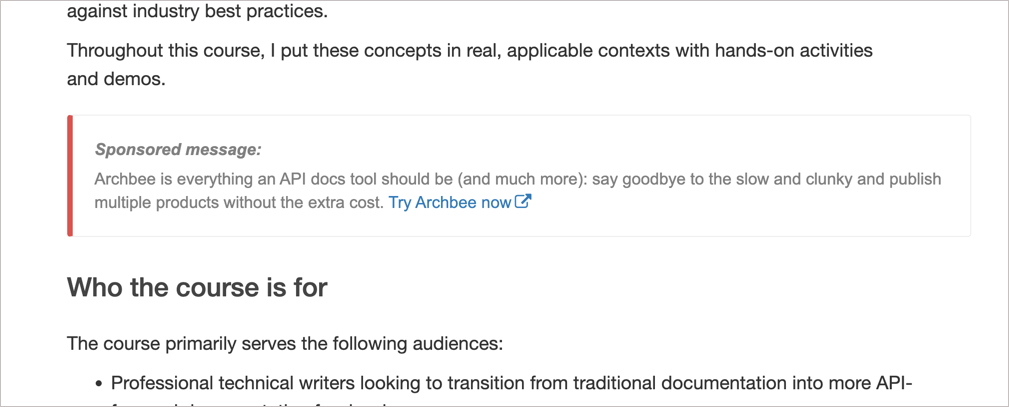
The text snippet’s text changes randomly with each page refresh. Additionally, the location of the snippet is random from page to page.
Text snippets get about 15-25 clicks per month.
The text snippets give you more flexibility to get your messaging across. You’re not limited to a graphic or article title but can expand with more detail, and cycle in multiple messages to try to communicate your product. Text snippets don’t fall into the trap of banner blindness and fit right in line with the reader’s eye.
The text snippets are denoted with alert-type formatting, with text that says “Sponsored message” prefacing the ad. Pages not included are contact, search, error, or other non-content heavy pages. A maximum of 3 inline snippets (from different advertisers) can appear on each page. Links are rel=nofollow.
The cost for inline text snippets to appear on the API doc site is $1,800 per year.
Newsletter summaries
I sent out two newsletters per month to 6,200+ email subscribers. I also post the newsletter content on my blog and share the link on Linkedin and Twitter. The newsletter has an average open rate of about 35%, meaning of the 6,200 people who receive the newsletter, about 2,200 open the email. Here’s an example of a newsletter summary:
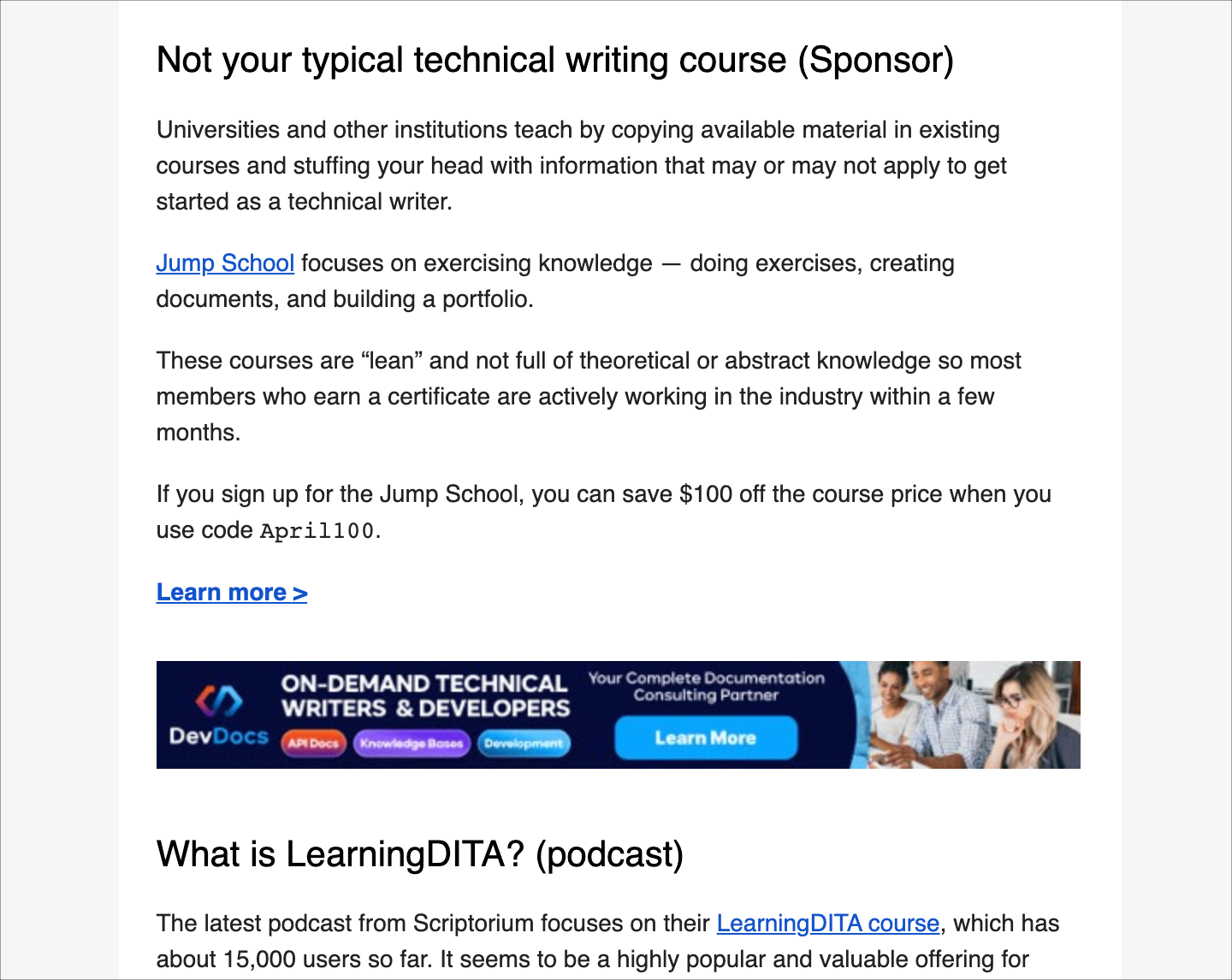
These newsletters contain summaries of my latest posts, plus the latest happenings in tech comm, such as articles, tools, issues, or other matters. You can see a list of recent newsletters on my newsletter category. Sponsored summaries have the word “(Sponsor)” in parentheses in the title.
Each newsletter typically has 4 article summaries + 1 sponsor summary. The sponsor summary is a two-paragraph chunk of text that you provide, describing your product, service, event, etc. Whatever you want the tech writer world to know about, you can share it in this summary. I might lightly edit the summary for style to fit the newsletter.
Each newsletter summary gets an average of 75 clicks. The cost for a newsletter summary is $150 per newsletter.
Newsletter banners
The newsletters also feature banner ads that are 540px wide by 70px tall in size. The banner ads intersperse the newsletter summaries as shown in the following image:
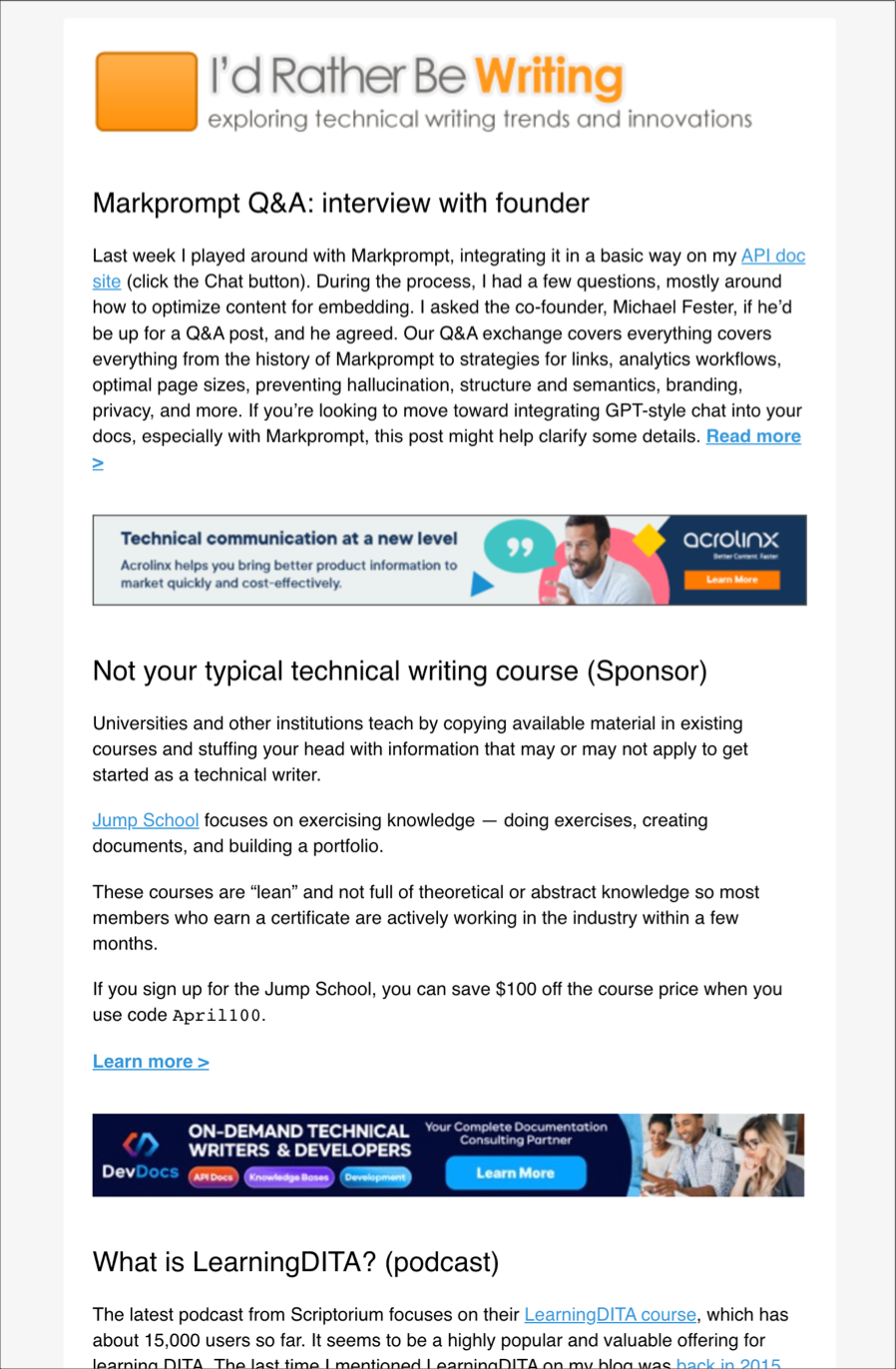
Newsletter banner ads typically receive about 10 clicks per newsletter. As part of the newsletter, they also receive about 2,200 page views per newsletter.
I usually include about 4 banner ads per newsletter, with each banner ad separating the text summary.
The cost for advertising in the newsletter space is $100 per newsletter
Footer banner ads
The footer banner ad space (728 x 90px) appears below each post, right above the comments, in the single post view. This visible space is inline with the reader’s eye and provides a natural click-point after a reader finishes reading a post. The expanded size gives you more room to communicate a message and use other display graphics.
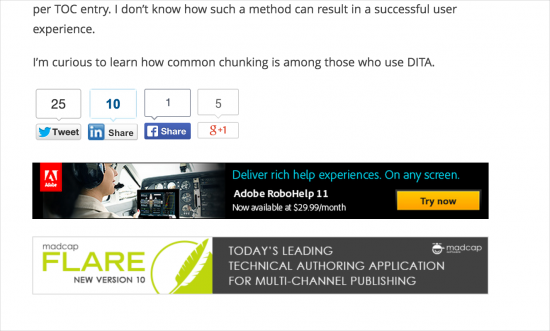
Footer banner ads can be JPG, PNG, or SVG. Animated GIF is not allowed. Like the sidebar, the position of the horizontal banner ads rotate randomly with each page refresh. There’s a limit of 4 horizontal banner post ads that can appear below the post.
Footer banner ads typically receive 50 clicks per month.
The cost for a Horizontal banner ad is $1,500 per year.
Taking the next step
If you’d like to advertise on my site, contact me. We’ll finalize details about the ad spaces you want, and then I’ll send you an invoice via PayPal.
About Tom Johnson

I'm an API technical writer based in the Seattle area. On this blog, I write about topics related to technical writing and communication — such as software documentation, API documentation, AI, information architecture, content strategy, writing processes, plain language, tech comm careers, and more. Check out my API documentation course if you're looking for more info about documenting APIs. Or see my posts on AI and AI course section for more on the latest in AI and tech comm.
If you're a technical writer and want to keep on top of the latest trends in the tech comm, be sure to subscribe to email updates below. You can also learn more about me or contact me. Finally, note that the opinions I express on my blog are my own points of view, not that of my employer.


